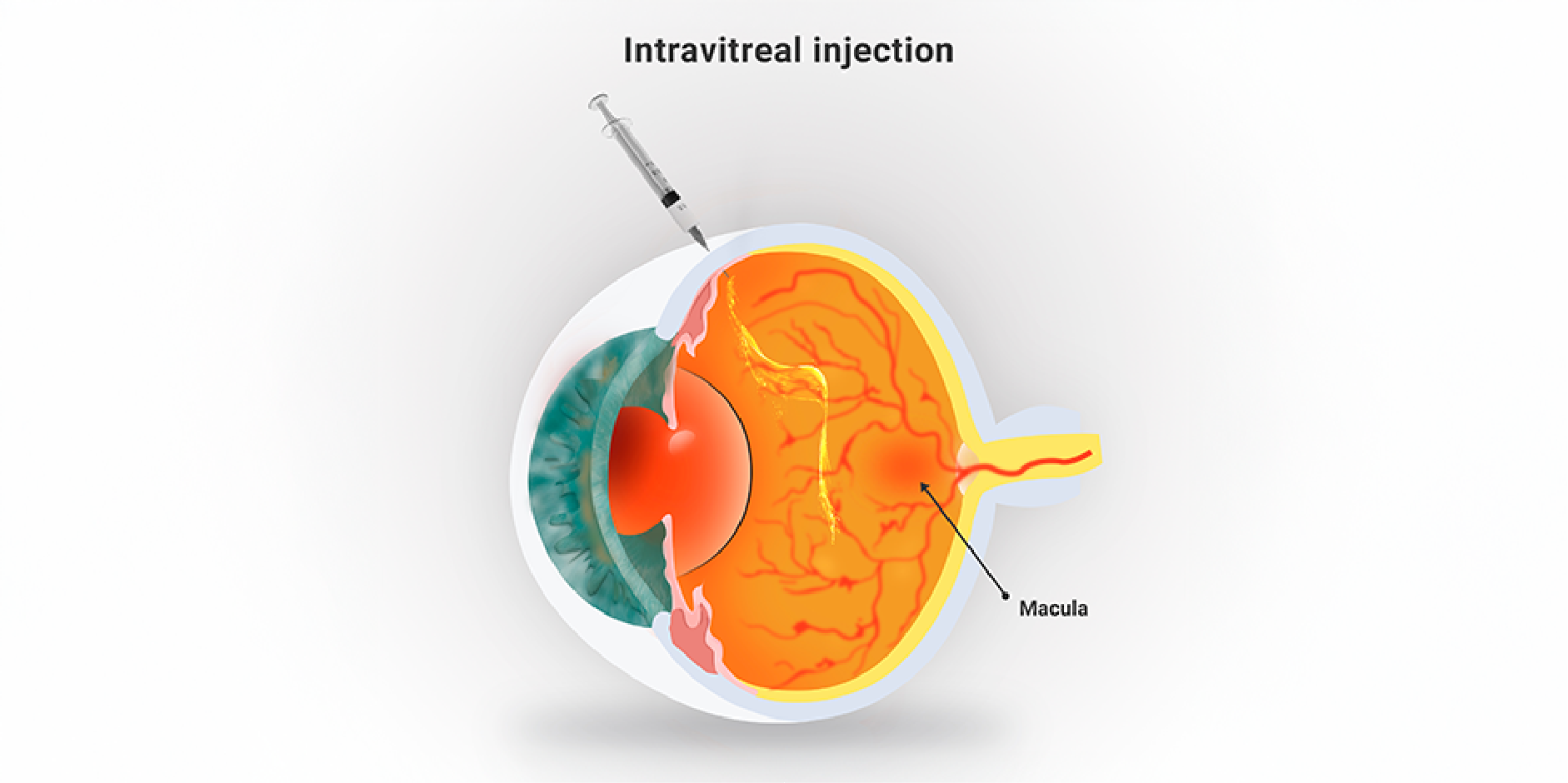Content on this page:
Content on this page:
Principles of Therapy
The goals of therapy in age-related macular degeneration are to preserve visual function and to stop disease progression. Early detection and treatment of AMD to halt deterioration of vision is important to help preserve the patient’s quality of life and independence. Treatment options for AMD include observation, antioxidant treatment and mineral supplements, intravitreal injection of anti-VEGF agents (the choice of agent should be individualized), PDT, and laser photocoagulation therapy.
Pharmacological therapy
Intravitreal Anti-Vascular Endothelial (VEGF)
Injection Therapy
Intravitreal anti-VEGF injection therapy is the
recommended first-line treatment for patients with neovascular or late or wet
AMD. Its use exhibited improved visual and anatomic outcomes compared to other
therapies. It controls the progression of exudative AMD and stabilizes or
reverses visual loss. Notably, there are no clinically significant differences
in the effectiveness and safety between different anti-VEGF agents.
 Age-Related Macular Degeneration_Management 1
Age-Related Macular Degeneration_Management 1Aflibercept
Aflibercept is a pan-VEGF and placental growth factor (PGF) inhibitor. It is a recommended treatment option for patients with neovascular or wet or AMD with macular CNV.
Bevacizumab
Bevacizumab is a recombinant monoclonal antibody that binds to all isoforms of VEGF. It has been used off-label in the treatment of neovascular AMD. Improved in visual acuity and decreased retinal thickness has been observed following intravitreal treatment.
Brolucizumab
Brolucizumab is a humanized single-chain antibody fragment that inhibits all forms of VEGF-A. It is a treatment option for patients with neovascular AMD with macular CNV.
Pegaptanib Sodium
Pegaptanib sodium is an RNA oligonucleotide that is a selective VEGF antagonist which binds to the 165 isoform of VEGF-A. It is indicated for all subtypes of neovascular AMD.
Ranibizumab
Ranibizumab is a recombinant humanized immunoglobulin that binds and inhibits the action of all isoforms of VEGF-A. It is a recommended treatment option for all subtypes of neovascular AMD. It is indicated for active subfoveal CNV as shown by studies as it improves visual acuity and prevents leakage and progression of neovascularization.
Complement Pathway Inhibitors
Example drugs: Avacinaptad pegol, Pegcetacoplan
Complement pathway inhibitors have been recently approved by the US Food and Drug Administration (US FDA) for the treatment of geographical atrophy with or without subfoveal involvement. Avacinaptad pegol inhibits the cleavage of C5 which prevents the formation of the membrane attack complex. It has been demonstrated to show a significant reduction in the mean rate of lesion growth by 14.3% compared to placebo at 12 months. On the other hand, Pegcetacoplan is a pegylated complement C3 inhibitor peptide that demonstrated a significant reduction in lesion growth over a 24-month period in a phase III study. However, trials have shown no improvement of visual acuity. There were also reports of serious vasculitis and significant vision loss after Pegcetacoplan approval.
Vitamin and Mineral Supplements (Antioxidant)
Vitamin and mineral supplements have been indicated in patients with either intermediate AMD or advanced AMD in one eye. A daily dose of combination of 500 mg Vitamin C, 400 IU Vitamin E, 80 mg Zinc, 2 mg Copper, 10 mg Lutein, and 2 mg Zeaxanthin was found to reduce the risk of progression to advanced AMD. Beta-carotene is replaced with Lutein and Zeaxanthin because it is associated with increased risk for lung cancer in smokers and those who recently quit smoking.
Photodynamic Therapy (PDT) with Verteporfin
Verteporfin is a photosensitizing dye given by IV before laser light administration in PDT for predominantly classic, subfoveal neovascular AMD. It is a less commonly used treatment option for patients with neovascular AMD with new or recurrent macular CNV, where the classic component is >50% of the lesion and the entire lesion is ≤5400 µm in greatest liner diameter. It may be used for neovascular AMD with occult CNV with vision <20/50 or if the vision is >20/50 but the CNV is <4 macular photocoagulation studies (MPS) disc areas in size. PDT has minimal damage to the overlying retina than laser photocoagulation therapy because the energy from the laser is taken up by the Verteporfin causing damage vascular endothelial cells and thrombotic occlusion of the blood vessels within the CNV lesion. It also reduced the risk of moderate to severe visual loss. It must be noted that most patients will still have loss of vision, and that visual improvements are unusual.
Nonpharmacological
Observation
Observation
is a treatment option for patients with non-neovascular early AMD (AREDS
category 2) or advanced AMD with bilateral subfoveal geographic atrophy or
disciform scars. It may also be considered in patients with late AMD if disease
appears stable without giving anti-VEGF therapy.
Patient
Education
It
is important to instruct patients with AMD on how to test their vision daily or
at least weekly, while patients with exudative AMD or have had laser treatment
should be instructed on how to monitor the size of their blind spots or the
appearance of new ones. High risk patients (eg with early AMD and/or with
family history of AMD) are encouraged to have regular dilated eye exams for the
early detection of the intermediate stage of AMD. Patients at very high risk
(eg presence of advanced AMD in one eye and large drusen with RPE changes in
the fellow eye) should be examined every 6 to 12 months to detect asymptomatic
CNV at a treatable stage. For low-risk patients, it is recommended to have a
comprehensive eye evaluation as follows: For patients 40 to 54 years old,
examination is every 2 to 4 years. For patients 55 to 64 years old, examination
is done every 1 to 3 years. Patients ≥65 years old, examination is done every 1
to 2 years. Patients should be informed about the symptoms of progressing CNV
(eg progressive decrease in central vision) and counseled on the need for
prompt consultation with an ophthalmologist. Smoking cessation should be done
as this is the main modifiable risk factor for AMD. Diet that includes leafy
green vegetables, fresh fruits, and fishes rich in omega-3 fatty acids may help
decrease the risk for AMD. The ideal body weight should be maintained. It is
noted that increased body mass index (BMI) and abdominal obesity have increased
risk for AMD. In bight environments, sunglasses with 100% protection against
UVA and UVB should be worn. Lastly, blood pressure should be monitored and
controlled.
 Age-Related Macular Degeneration_Management 2
Age-Related Macular Degeneration_Management 2Rehabilitation
Vision rehabilitation is useful in heightening the patient's functional ability. Low vision rehabilitation by using magnifiers and low vision aids is recommended for advanced non-neovascular AMD patients.
Surgery
Laser
Photocoagulation
Laser
photocoagulation is indicated in patients with extrafoveal classic CNV. It may
be used as treatment option for patients with juxtapapillary CNV. It destroys
the neovascular complex with heavy confluent laser and thereby decreases
further loss of vision. Monitoring should be done as it can cause scotoma and
recurrences that usually appear a year after therapy. Complications include
severe vision loss which may be permanent following treatment and rupture of Bruch’s
membrane with subretinal or vitreous hemorrhage.
